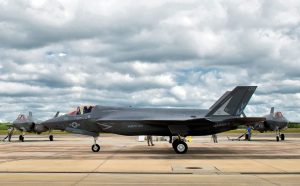South Korea has rolled out the prototype of its new indigenous fighter, the KF-21 Boramae. The new jet will complement the country’s mostly American-made fleet, fitting between its older F-15 and F-16 fighters and complementing its brand-new, fifth-generation F-35s.
As fighter aircraft have gotten more complex and expensive, it has become rarer for middle powers to produce their own. That is not to say that efforts are not being made: Turkey, Japan, India and Britain have all launched programs to develop their own fifth- (or, notionally, sixth-) generation fighters, though only Japan’s has flown, and that only in prototype form. As a result, it is impossible to determine conclusively yet whether middle powers can successfully and economically compete with the existing fifth-generation fighters developed by Russia, China and the United States.
In principle, though, it is easy to understand why they would try. But the issue is that being “successful” — building an aircraft which can survive and accomplish strategic missions on the battlefield of the future is one thing. Doing so in a financially sustainable way is a completely different and potentially more challenging task.
Right now, for countries aligned with the United States, there is only one fifth-generation aircraft available: the F-35. (The USAF also flies the slightly older but bigger and faster F-22 Raptor, but that jet was specifically barred for export by Congress and production ceased a decade ago, so there is no realistic prospect of export sales.) As a result, the niche that another nation’s defense industry could potentially fill is defined by the boundaries of what the F-35 is and isn’t.
The point of the F-35 was to be all things to all users: a surgical strike fighter, a stealthy air-to-air combatant, a battlefield connectivity and reconnaissance node, a carrier battle group force multiplier, and a close air support platform capable of operating independently of large, vulnerable airstrips or carriers. The compromises that were made at the design stage to create a flying Swiss Army knife have been well-documented, so I will not rehash them here.
The optimistic take on the F-35 is that there is a well-trodden history of military aircraft being saddled with contradictory and overoptimistic mission requirements and passing through a protracted and expensive development hell before becoming successful systems – the F-4 Phantom, for example. But even that optimistic take relies on the acknowledgment that the F-35 has become too big to fail: there is not a replacement program waiting in the wings, hundreds are already in service, entire allied procurement strategies have been built around this specific aircraft.
The degree to which the F-35 has ended up as a jack of all trades, master of none, does create openings for countries that might blanche at its eye-watering costs, worry about its availability rate, or need capabilities that do not match its specialties. A short-ranged, single-engine, stealthy fighter might not be the best pick for a country with a large nautical Exclusive Economic Zone and not much prospective need for penetrating strike missions, for example.
That brings us back to the Boramae, which Seoul hopes to put into production by 2026. Rather than a true, stealthy, fifth-generation fighter, it is designed as a stepping stone: its shape is designed to minimize its radar signature, but it will carry its stores externally, which is incompatible with true stealth (a fifth-generation hallmark). Facing a primary adversary whose air defense radars lag behind the state of the art, but whose arsenal is vast and growing, a slightly less capable fighter which can be purchased in greater numbers makes sense, especially if its limitations can be addressed over time. And to make the development math work, Seoul is presumably gambling that other countries are facing similar strategic dilemmas — and has already signed Indonesia on as a development partner.
It is, however, a gamble. Recent history is replete with examples of companies — American, European and otherwise — trying to carve out a niche for cheaper, creatively-designed aircraft designed to provide 90 percent of the capability for 50 percent of the cost. Most fail, partly because there are both political and tactical advantages in buying from one of the superpowers; partly because there is a vibrant marketplace for lightly used combat aircraft, which are often cheaper than any new option; and partly because there are few enough examples of such high-end systems being used in real combat that a system with any kind of record is likely to be seen as more reliable than an untried one.
The Boramae may well hit its design goals and enter service, and the South Korean government may well be calculating that the boost to domestic industry will make its investment worthwhile even if it doesn’t also become an export success like Sweden’s Gripen. But even in a re-arming world, the market for fighter jets is not enormous, and competing with the biggest players takes more than just a good product.

































